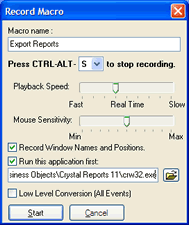What is a Macro Recorder?
Macro Scheduler‘s Macro Recorder allows you to record a sequence of events to create a macro. The Macro Recorder will record keystrokes, mouse events and window activations, including window positions and dimensions. This makes it easy to create a macro that can be played back to run the task automatically.
The Macro Recorder creates real MacroScript code that is easy to understand and edit so that you can make modifications easily. When recording a macro you can specify an application to automate so that the Macro Recorder can add the code to open the application and position it in the same place on the screen each time so that your macro will always work correctly.

When you record a macro you can specify the playback speed and mouse sensitivity. Adjusting the playback speed effectively reduces or lengthens the time between individual steps. It is usually best to leave this in real time as reducing time between events can in some instances make the macro less reliable – the system needs the thinking time between those events. Reducing mouse sensitivity means you can remove unnecessary mouse moves between mouse clicks, for example, thus shortening the script and making it easier to read and edit.
The Macro Recorder is ideally suited to less technical users, or those new to Macro Scheduler who want to learn the MacroScript language to make their macros more powerful and more reliable in changing environments. The Macro Recorder in combination with the optional script compiler allows a user to create a standalone Windows application that will run on any PC to automate repetitive tasks in just a few simple mouse clicks.
As well as Macro Recorders, Macro Scheduler includes powerful Code Wizards which are just as easy to use but create more specific, more powerful and more reliable code than the basic macro recorder. See Macro Recorder vs Code Wizards.